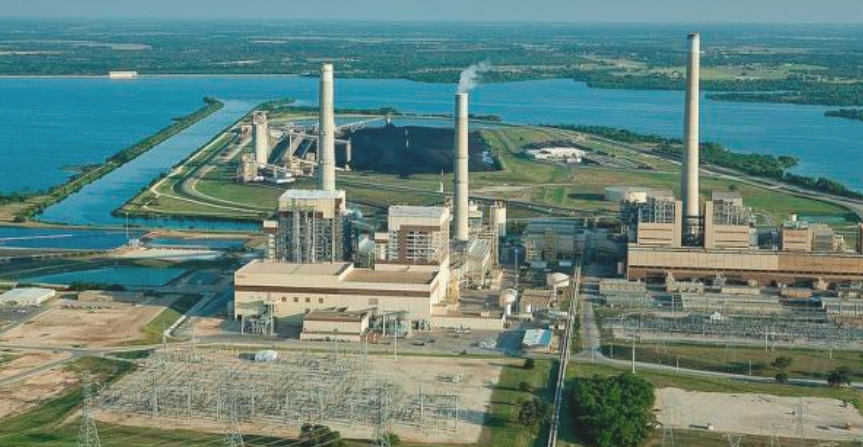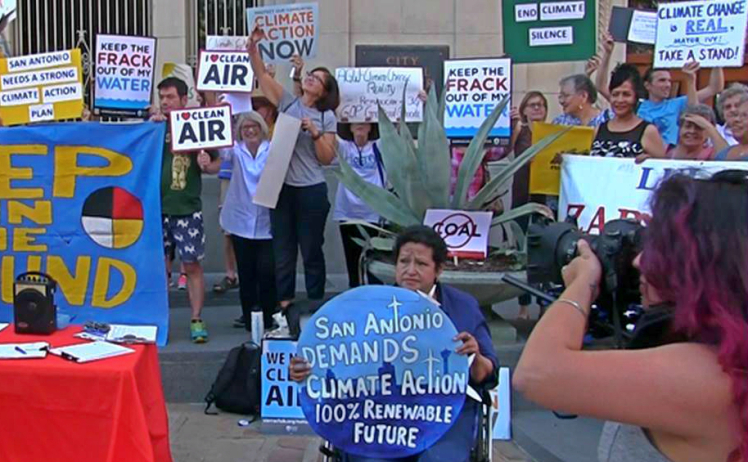By Greg Harman, San Antonio Organizer
US industrial greenhouse gas emissions responsible for the rapid warming of the earth may have dipped slightly last year, but in San Antonio they took a sharp jab skyward, according to numbers released last week by the US Environmental Protection Agency (EPA).
In 2017, San Antonio area power plants and industry belched out roughly 1.6 million more metric tons of climate-destabilizing gases than they did in 2016, according to the EPA’s Greenhouse Gas Reporting Program (GHGRP).
Overall, Bexar County’s contribution to the global climate crisis from large industrial sources grew from 11.9 million tons of CO2e, or carbon dioxide equivalent, to 13.5 million tons CO2e. (CO2e represents the standard unit for measuring a facility’s carbon footprint.)
Most significant in this increase was the ramping up of City-owned CPS Energy’s JT “Dirty” Deely coal plant resulting in the generation of an additional 1.47 million tons of pollution, from 2.77 million tons in 2016 to 4.2 million tons in 2017. Emissions from CPS’s younger coal plant also grew, from 5.5 million tons to 5.9 million tons from 2016 to 2017.

"Dirty Deely" off of San Antonio's Calaveras Lake is expected to be decommissioned later this year. Photo: CPS Energy
Statewide emissions followed the same course.
Texas's industrial emitters blew out 5 million metric tons more greenhouse pollution in 2017 than they did in 2016, according to the GHGRP, which began capturing data in 2010 and covers all industrial facilities emitting more than 25,000 tons of greenhouse gases per year.
Among the top 10 Texas climate polluters, only the refineries of Baytown and Galveston saw decreases.
Texas's Top 10 Climate Polluters (million metric tons)
-
Martin Lake Coal Plant: 13.9
-
Sam Seymour Coal Plant: 11.9
-
Monticello Coal Plant: 10 (CLOSED)
-
Limestone Coal Plant: 9.7
-
Sandow Station Coal Plant: 8.9 (CLOSED)
-
Big Brown Coal Plant: 8.3 (CLOSED)
San Antonio’s Top Climate Polluters (metric tons)
-
JK Spruce Coal Plant: 5.9 million
-
JT Deely Coal Plant: 4.2 million (CLOSING 2018)
-
VH Braunig Gas Plant: 1.2 million
-
Alamo Cement: 807,000
-
Capitol Aggregates: 452,000
-
OW Sommers Gas Plant: 296,000
-
Tessman Road Landfill: 189,000
-
Nelson Gardens Landfill: 108,000
-
Leon Creek Gas Plant: 59,000
If San Antonio's numbers remain high when the EPA releases their 2018 data next October (assuming the GHGRP program isn't eliminated, as Trump has threatened of the EPA as a whole). Texas as a whole will look a bit better, with this year's closure of Big Brown, Monticello, and Sandow. CPS is expected to close JT “Dirty” Deely by year's end.
Texas is not immune from the weight of the collapsing coal industry—a collapse in large part due to the poor economics of coal in the Texas market alongside the rapid growth of renewables and natural gas.
Writes the Daily Energy Insider:
"As coal-fired power plants in the United States grow increasingly uneconomic, capacity retirements by year end are likely to hit a record 15.4 gigawatts (GW), exceeding the previous record of 14.7 GW set in 2015, according to a new report by the Institute for Energy Economics and Financial Analysis (IEEFA).
The IEEFA report outlines how 44 units at 22 coal-fired plants will likely be closing in 2018 in an environment where aging and costly coal plants can no longer compete against cheaper renewables and gas-fired generation. Sizable coal plant closures are imminent in 14 states, including Florida, Indiana, Kansas, Kentucky, Maryland, Minnesota, Missouri, Ohio, Pennsylvania, Tennessee, Texas, Virginia, West Virginia, and Wisconsin."
Another gem we can glean from these numbers? While City-owned CPS Energy has pledged to close down the decades-old Deely by the end of the year—scrubbing millions of tons of climate pollution and a huge amount of toxic pollution from our air—until then they’re going to make that old plant work for its keep.
“It isn’t really surprising that CPS Energy would run these plants hard when the market is tight and prices are favorable. But we expect the market to quickly adjust as we continue to see more clean energy and soon storage at scale. This will further push coal to the fringes of economic competitiveness, probably even before we are able to hold coal properly accountable for its deadly pollution and climate wrecking GHG emissions,” said Chrissy Mann, Sierra Club Beyond Coal Campaign Representative.
CPS has been taking advantage of extreme summertime heat and record-breaking electricity demand to sell more power from their old coal plants into the open ERCOT market.
Deely’s coming closure is hopefully just an appetizer. The City’s developing climate action plan is advancing a vision of net zero energy emissions by 2050. And a coalition of community organizations, including the Alamo Group and Lone Star Chapter, are pushing the process to get carbon reductions done faster than that.

Climate Action SA—a coalition of more than 30 community organizations dedicated to a grassroots-led and justice-driven climate plan for San Antonio—is calling for zeroing out all coal power at CPS Energy by 2025 and net-zero electricity generation by 2030 in order to help keep global warming to 1.5 degrees Celsius or below, in keeping with the latest research of the Intergovernmental Panel on Climate Change.
To support the struggle in San Anto, sign Climate Action SA’s petition and register for the coalition's newsletter.